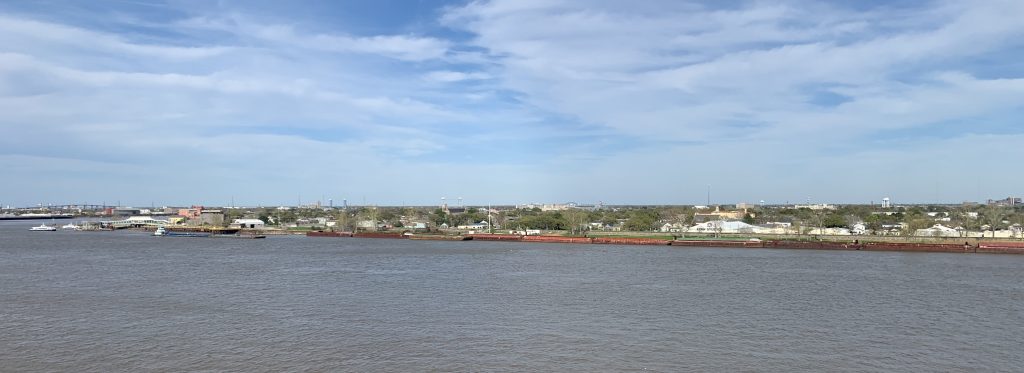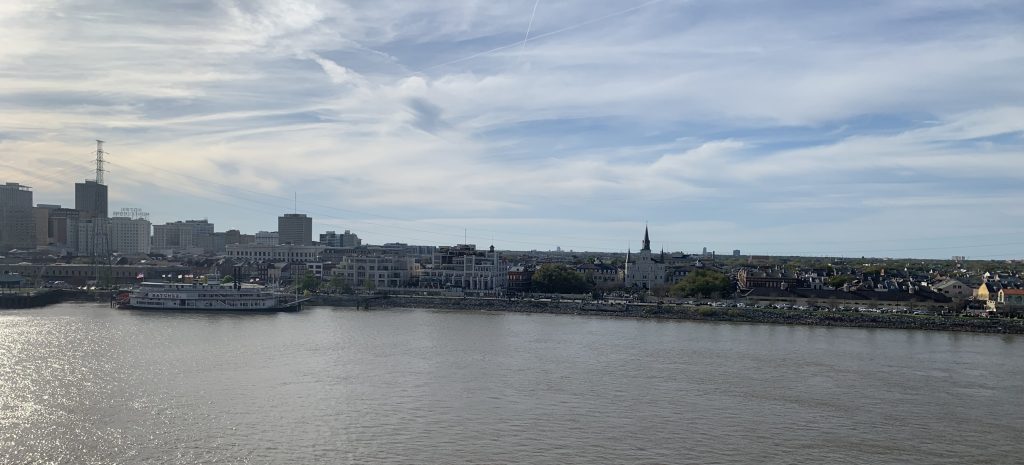Cruising Down the Mississippi at Night
During spring break, my wife Brittany and I took a cruise into the Gulf of Mexico and Caribbean Sea. We deliberately chose a cruise leaving out of New Orleans, our hometown, so we could both spend some brief moments with family and to also have the experience of cruising down the Mississippi River. As Emerging Civil War’s readers might expect, there were a host of Civil War-themed sites to see on the journey downriver.
Even before casting off, there were a Civil War-themed view to take in, though admittedly it is not much to see. Across the river from the docked cruise ship, looking on its western bank, you could see where the city’s 19th century dry-docks were located. Today, they house more docks, wharves, and collection points for river barges, as well as a landing site for one of the area’s ferry crossings. One hundred and sixty years ago, however, this was where the dockyards of John Hughes and Company, the largest shipyard system in the Crescent City, were located. These docks helped outfit Confederate warships in the Civil War’s first year, including the famed CSS Sumter, the first Confederate ironclad CSS Manassas, the flagship of the Confederacy’s Mississippi River Squadron CSS McRae, vessels of the Confederate River Defense Fleet, and the two steamers of Louisiana’s wartime navy.[1] After United States forces regained control of New Orleans, the same docks helped repair U.S. warships plying the Mississippi.

The cruise ship departed the New Orleans wharves at about 5:00 pm, steaming downriver. Within a few minutes, we were treated to the spectacular view of the city’s French Quarter, with the paddle-wheeler Natchez and the famed St. Louis Cathedral in perfect view. This was the sight that David Farragut’s ships observed when they first anchored at the city on April 25, 1862.

Several miles downriver from the French Quarter, outside the official city limits of New Orleans itself, lies Jackson Barracks. Just like Jackson Square and Fort Jackson further downriver, the site honors Andrew Jackson for his famous victory at New Orleans against the British in 1815. During the Civil War, Jackson Barracks housed both Confederate and United States soldiers, as it was then a site for the Louisiana militia. It remains so today, as a site for the Louisiana National Guard. The successor unit for the Civil War-era Washington Artillery of New Orleans is headquartered there, and it contains a museum documenting the state’s military history.

Just downriver from Jackson Barracks lies the Chalmette battlefield, site of Jackson’s victory in the battle of New Orleans. It too, has many Civil War connections. In 1862, after Farragut’s Western Gulf Blockading Squadron passed Forts Jackson and St. Philip, the warships proceeded upriver to New Orleans. Before anchoring at the city on April 25, however, Farragut’s leading ships engaged Confederate batteries at Chalmette and directly across the river at McGehee under the command of Louisiana Militia Brigadier General Benjamin Buisson. Chalmette was manned by three regiments of Louisiana militia, while McGehee was manned by a battalion of infantry, a company of heavy artillery, and a light artillery battery. The Confederates failed to stop Farragut’s ships, largely because they only held about twenty rounds of ammunition for each cannon on site because the rest was sent downriver to support Forts Jackson and St. Philip. Once their ammunition was exhausted, the Confederates withdrew, leaving Farragut’s ships to proceed to New Orleans itself.[2]
The Chalmette Battlefield also has United States Civil War connections. The site was used as a collection and staging point for troops being moved to the New Orleans area. In 1865, when Philip Sheridan led 50,000 men to the Rio Grande in efforts to show US displeasure at the Maximilian government of Mexico, those men rendezvoused at Chalmette.[3] Finally, there is a major national military cemetery, with Civil War soldiers buried there, including many African American soldiers who died in wartime New Orleans.

Day shifted to night as the cruise ship proceeded north, south, east, and west in efforts to move generally southeast. The next major Civil War site to see was seventy-five miles downriver. This was forts Jackson and St. Philip, the site of the major battle fought on April 24, 1862. Here, thirteen of David Farragut’s ships successfully passed the Confederate forts (three more tried and could not pass and another was sunk in the effort). After passing the forts, they engaged eleven Confederate warships in the largest ship-to-ship fleet engagement of the Civil War.[4]


Being the middle of the night, it was nearly impossible to make out the fortifications, but in a sense that was the point. I was able to view the river battle site in the relative darkness that soldiers and sailors fought in, though of course once artillery was fired, ships exploded, and Confederate fire rafts were released the river lit up a great deal. I managed to get a few photos of the dark riverbank near Fort Jackson, taken roughly where the Confederate warships were positioned at the beginning of the battle, looking on at another cruise ship in roughly the same position that Farragut’s ships began their assault.
There was one more Civil War site to see below Fort Jackson: the Head of Passes. This is where the numerous entrance channels of the Mississippi River delta converge into the main river channel itself (the Southwest Pass, South Pass, and Pass á l’Outre being the primary channels of the Civil War). This was the site of the October 1861 battle of the Head of Passes, where a makeshift Confederate riverine force under George N. Hollins, spearheaded by the just-seized ironclad Manassas, assaulted the U.S. blockade. The blockading ships retreated down the Southwest Pass, temporarily leaving the other passes of the river undefended. It was the first real challenge to the U.S. blockade in the war.[5]


We passed the Head of Passes at near midnight, following the path of CSS Manassas as it led the Confederate squadron downriver to make the October 1861 attack. Again, I snapped some photos in the darkness, recording what that darkness looked like. Beyond that was the open Gulf of Mexico, where I snapped one last image of the line where the fresh water of the Mississippi River meets the salt water of the Gulf. The phenomena was well known in Civil Wat times, with U.S. General Halbert E. Paine wrote in his diary on April 16, 1862 about how “the dividing line between the blue water of the ocean and yellow water of the Mississippi is well defined, for miles, at sea. The surface water is fresh for several miles from land.”[6] Just as it was Paine’s introduction to the Mississippi River in the war, that same line where fresh and salt water was my introduction to the Gulf of Mexico for this trip.

In January 2022, I completed a similar walking tour of the New Orleans French Quarter area for Emerging Civil War, documenting Civil War era sites on land. This seems a good companion to that, allowing readers to get a better sense of the geography and a few of the locations the Crescent City has to offer for Civil War enthusiasts.
Endnotes:
[1] Treasury Department, Second Auditor’s Office to James A Seddon, July 8, 1863, and Payment Receipt for Gunboat Defiance, March 29, 1862, John Hughes and Company Papers, Confederate Papers Related to Citizens or Business Firms, M346, Records Group 109, US National Archives; Neil P. Chatelain, Defending the Arteries of Rebellion: Confederate Naval Operations in the Mississippi River Valley, 1861-1865, (El Dorado Hills, CA: Savas Beatie, 2020), 13, 48
[2] Chatelain, Defending the Arteries of Rebellion, 170.
[3] Philip H. Sheridan, Personal Memoirs of P.H. Sheridan, (New York: Charles L. Webster & Company, 1888). Vol. 2, 205-228.
[4] Chatelain, Defending the Arteries of Rebellion, 153-169.
[5] Neil P. Chatelain previously wrote about this battle and how CSS Manassas was used in it. Confederate ironclads also tried breaking the blockade at Hampton Roads in March 1862 and at Charleston in January 1863. In all cases the blockade was dented, but not permanently broken.
[6] Samuel C. Hyde Jr., ed., A Wisconsin Yankee in Confederate Bayou Country: The Civil War Reminiscences of a Union General, (Baton Rouge, LA: Louisiana State university Press, 2009), 34.
Civil War history on the midwatch — fantastic. thanks Neil.